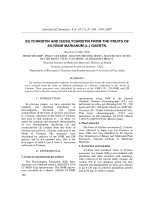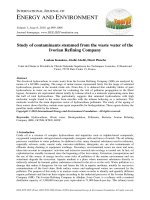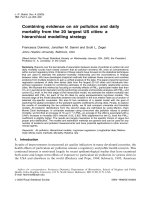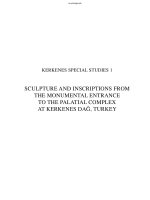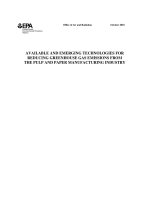Prototane - Type triterpenes from the rhizomes
Bạn đang xem bản rút gọn của tài liệu. Xem và tải ngay bản đầy đủ của tài liệu tại đây (107.58 KB, 6 trang )
120
Journal of Chemistry, Vol. 45 (1), P. 120 - 125, 2007
PROTOTANE-TYPE TRITERPENES FROM THE RHIZOMES OF
ALISMA PLANTAGO-AQUATICA
Received 30 August 2006
CHAU VAN MINH
1
, PHAN VAN KIEM
1
, PHAM HAI YEN
1
, TRAN THU HUONG
2
,
ALESSANDRA BRACA
3
1
Institute of Natural Products Chemistry, VAST
2
Department of Chemical Technology, Hanoi University of Technology
3
Department of Bioorganic Chemistry and Biopharmaceutics, University of Pisa, Italia
SUMMARY
Three terpenes with Protostane type were isolated from the rhizomes of Alisma plantago-
aquatica. The chemical structures of isolated compounds were characterized as 11
,23S,24R,25-
tetrahydroxyprotost-13(17)-en-3-one (alisol A, 1), 11
,23S,25-trihydroxyprotost-13(17)-en-3-
one-24R-yl acetate (alisol A acetate, 2), and 11
,23S,24S-trihydroxyprotost-13(17),25-dien-3-one
(alisol G, 3), by detailed analysis of the 1D- and 2D-NMR spectra such as
1
H-,
13
C-NMR, DEPT
90, DEPT135, HSQC, HMBC,
1
H-
1
H COSY, and by the Electronspray Ionization (ESI) mass
spectrum. This is the first report of alisol G from Alisma plantago-aquatica.
I - INTRODUCTION
The dried rhizome of Alisma plantago-
aquatica L. var. orientalis Samuelsson is a
crude drug, and has been used as a folk
medicine for diabetes and swellings [1]. From
the phytochemical investigations including its
physiological active principles, it was reported
to contain protostane-type triterpenoids, e.g.
alisol A and its 24-acetate, alisol B and its 23-
acetate and alisol C and its 23-acetate [2 - 5]
and many other components isolated from fresh
rhizome Alismatis orientale and the crude drug
Alismatis rhizoma of Japanese and Chinese
origins [6]. Here, we report the isolation and
structural determination of three terpenes with
Protostane type as 11,23S,24R,25-tetrahy-
droxyprotost-13(17)-en-3-one (alisol A, 1),
11,23S,25-trihydroxyprotost-13(17)-en-3-one-
24R-yl acetate (alisol A acetate, 2), and
11,23S,24S-trihydroxyprotost-13(17),25-dien-
3-one (alisol G, 3) from the rhizomes of this
plant.
II - EXPERIMENTAL
1. General experimental procedures
The
1
H-NMR (500 MHz) and
13
C-NMR
(125 MHz) spectra were recorded on a Bruker
AM500 FT-NMR spectrometer using TMS as
the internal standard. The Electronspray
Ionization (ESI) mass spectrum was obtained
using a AGILENT 1100 LC-MSD Trap
spectrometer. Column chromatography (CC)
was performed on silica gel (Kieselgel 60, 70 -
230 mesh and 230 - 400 mesh, Merck) or YMC
RP-18 resins (30 - 50 µm, FuJisilisa Chemical
Ltd). Thin layer chromatography (TLC) was
performed on DC-Alufolien 60 F254 (Merck
1.05715) or RP18 F254s (Merck) plates.
2. Plant material
121
The rhizomes of Alisma plantago-aquatica
L. var. orientalis Samuelsson were collected in
Tam Dao Mountain, Vinh Phuc Province in
January, 2006 and were identified by Dr Tran
Huy Thai, Institute of Ecology and Biological
Resources, Vietnamese Academy of Science
and Technology.
3. Extraction and isolation
Air-dried and powdered rhizomes of Alisma
plantago-aquatica L. (6.0 kg) were extracted
with methanol to get the residue (150 g), which
was then suspended in water and extracted
sequentially using hexane, chloroform and ethyl
acetate to yield hexane (53 g), CHCl
3
(64 g),
EtOAc (13 g) extracts, and water layer (20 g).
Repeated chromatography of the CHCl
3
extract
(64 g) on a silica gel or YMC column with the
suitable solven systerms to get compounds 1
(250 mg), 2 (130mg) and 3 (54 mg) as white
crystals.
III - RESULTS AND DISSCUSSION
Compounds 1 - 3 were obtained as white
crystals from the methanolic extract. The
1
H-
NMR spectrum of 1 showed 7 singlets of the
quaternary methyl groups ( 1.00, 1.05, 1.06,
1.07, 1.13, 1.27, 1.21) and a doublet at 1.01
(3H, d, J = 7.0 Hz, H
3
-21), three protons of the
oximethine carbons at 3.88 (1H, ddd, J = 5.8,
10.7, 10.7 Hz, H-11), 3.76 (1H, d, J = 9.0 Hz,
H-23) and 3.76 (1H, d, J = 9.0 Hz, H-24). All
signals of the
1
H-NMR spectrum suggested that
1 is a triterpenoid. The
1
3
C-NMR and DEPT
spectra of 1 exhibited the signals of 30 carbons
including 8 methyl, 8 methylene, 6 methine and
8 quaternary carbons. The carbonyl group was
assigned at 220.5, a double bond without
olefinic protons was confirmed at 137.6 and
135.5, four carbons bearing oxygen atom
including three oximethine at 69.4, 69.9, 77.6
and a quaternary carbons at 74.1. The side
chain of 1 was connected from the spin-system
of the
1
H-
1
H COSY and was further confirmed
by the long-range correlations in the HMBC
spectrum as shown in table 1. All the NMR data
suggested the Protostane type of 1 resembling
those of alisol A. The hydroxyl group with
configuration was at C-11 confirmed by H-C
long-range correlations between H-11 and C-13
( 137.6)/C-9 ( 49.6)/C-10 (36.9) in the
HMBC spectrum and by the spin-coupling of
proton H-11 ( 3.88, ddd, J = 5.8, 10.7, 10.7
Hz) [6]. The carbonyl group was assigned to C-
3 from the cross peaks of protons H-23/H-24
and carbon C-3 in the HMBC spectrum.
Furthermore, the ESI spectrum of 1 exhibited
ion peaks at m/z 473 [M-H
2
O+H]
+
, 455 [M-
2H
2
O+H]
+
, 437 [M-3H
2
O+H]
+
and 419 [M-
4H
2
O+H]
+
, corresponding to the molecular
formula of C
30
H
50
O
5
. Consequently, 1 was
identified as 11,23S,24R,25-tetrahydroxy-
protost-13(17)-en-3-one (alisol A).
Table 1: The NMR data of compound 1
C
C
#
C
a,c
H
b,c
(J in Hz)
HMBC (H to C)
1 31.3 t 31.0 t 2.13 m; 2.26 m
2 33.9 t 33.7 t 2.34 m; 2.70 m
3 219.2 s 220.5 s -
4 47.1 s 46.9 s -
5 48.8 d 48.5 d 2.11*
6 20.3 t 20.0 t 1.32 m; 1.42 m
7 34.6 t 34.9 t 1.24 m; 2.03 m
8 40.8 s 40.4 s -
9 50.0 d 49.6 d 1.77 d (10.6) 11
10 37.2 s 36.9 s -
122
C
C
#
C
a,c
H
b,c
(J in Hz)
HMBC (H to C)
11 70.1 d 69.9 d 3.88 ddd (5.8, 10.7, 10.7) 9, 10, 13
12 34.8 t 34.4 t 2.80 dd (5.8, 13.2) 9, 11, 13, 14
13 137.2 s 137.6 s -
14 57.2 s 56.9 s -
15 30.8 t 30.5 t 1.34 m; 1.90 m
16 29.5 t 29.1 t 2.17 m
17 135.4 s 135.5 s -
18 23.4 q 23.0 q 1.13 s 13
19 25.8 q 25.6 q 1.05 s 5, 10, 9
20 28.7 d 28.3 d 2.77 m
21 20.3 q 20.1 q 1.01 d (7.0) 17
22 40.4 t 40.0 t 1.39 m; 1.67 ddd (4.2, 9.3, 13,9)
23 69.5 d 69.4 d 3.76 d (9.0)
24 77.6 d 77.6 d 3.01 br s
25 74.1 s 74.1 s -
26 27.6 q 27.3 q 1.27 s 24, 25
27 26.4 q 26.2 q 1.21 s 24, 25
28 29.8 q 29.5 q 1.07 s 4, 3, 5
29 20.4 q 20.0 q 1.06 s 4, 3, 5
30 24.3 q 24.1 q 1.00 s 7, 8, 9, 14
#
C
of
alisol A [6],
a
125 MHz,
b
500 MHz,
c
Measured in CDCl
3
*Overlap signals, Chemical shift are given in
ppm. Assignments were confirmed by COSY, 1D-TOCSY, HMQC, and HMBC experiments.
HO
O
R
OH
OH
1
2
3
4
5
6
7
8
9
10
11
12
13
14
15
16
17
18
19
20
21
22
23
24
25
26
27
28
29
30
1 R = OH; 2 R = OCOCH
3
HO
O
R
OH
1
2
3
4
5
6
7
8
9
10
11
12
13
14
15
16
17
18
19
20
21
22
23
24
25
26
27
28
29
30
3 R = OH
Figure 1: The structures of compounds 1 - 3
The NMR spectra of compound 2 were very similar to those of 1 except for the more appearence
of an acetate group in the NMR spectra of 2 (
C
170.8/20.7 and
H
2.20). This evidence suggested
that 2 was an acetyl derevative of 1. In the other hand, the ESI spectrum of 2 exhibited ion peaks at
m/z 515 [M-H
2
O+H]
+
, 497 [M-2H
2
O+H]
+
, 479 [M-3H
2
O+H]
+
, corresponding to the molecular
formula of C
32
H
52
O
6
. The NMR assignments of 2 were made from the comparison with those of 1,
and were further confirmed by HSQC and HMBC spectra of 2. The H-C long-range correlation were
123
observed between H-24 ( 4.61) and carbon carbonyl C-31 at 170.8, confirming that the acetate
group was connected to C-24. All NMR data of 2 were in good agreements with those of alisol A
24-acetate. Accordingly, 2 was determined as 11,23S,25-trihydroxyprotost-13(17)-en-3-one-24R-yl
acetate (alisol A 24-acetate).
Table 2: The NMR data of compound 2
C
C
#
C
a,c
H
b
,c
(J in Hz)
HMBC (H to C)
1 31.3 t 30.9 t 2.15 m; 2.30 m
2 34.0 t 33.7 t 2.36 m 2.73 m
3 219.2 s 220.5 s -
4 47.1 s 47.0 s -
5 48.8 d 48.6 d 2.12*
6 20.3 t 20.0 t 1.32 m; 1.49 m
7 34.6 t 34.3 t 1.28 m; 2.05 m
8 40.7 s 40.4 s -
9 50.0 d 49.5 d 1.77 d (10.6) 11
10 37.2 s 36.9 s -
11 70.0 d 69.8 d 3.88 ddd (5.8, 10.7, 10.7)
12 34.8 t 34.3 t 2.89 dd (5.8, 13.2) 9, 11, 13, 14
13 137.7 s 138.3 s -
14 57.2 s 57.0 s -
15 30.8 t 30.4 t 1.35 m; 1.92 m
16 29.4 t 28.9 t 2.18 m
17 135.0 s 135.0 s -
18 23.5 q 23.0 q 1.16 s 13
19 25.8 q 25.5 q 1.10 s 5, 10, 9
20 28.2 d 27.8 d 2.77 m
21 20.2 q 19.9 q 1.00 d (7.0) 17
22 40.0 t 39.6 t 1.39 m; 1.67 ddd (4.2, 9.3, 13.9)
23 69.1 d 69.0 d 3.88 d 9.0
24 78.8 d 78.7 d 4.61 br s 31
25 73.9 s 73.9 s -
26 27.6 q 27.2 q 1.18 s 24, 25
27 26.9 q 26.7 q 1.34 s 24, 25
28 29.7 q 29.5 q 1.11 s 4, 3, 5
29 20.4 q 20.0 q 1.01 s 4, 3, 5
30 24.3 q 24.1 q 1.02 s 7, 8, 9, 14
31 170.5 s 170.8 s -
32 21.0 q 20.7 q 2.20 s 31
#
C
of
alisol A 24-acetate [6],
a
125 MHz,
b
500 MHz,
c
Measured in CDCl
3
*Overlap signals and chemical shift
are given in ppm. Assignments were confirmed by COSY, 1D-TOCSY, HMQC, and HMBC experiments.
124
The NMR spectra of compound 3 were also
similar to those of 1, except for the more
appearence of the signals of a double bond at
C
144.7 (s), 114.1 (t) /
H
4.94 (br s) and 4.98 (br
s), instead of of the signals of a quaternary
carbon at 74.1, and the methyl group at
C
26.2/
H
1.21 as shown in the NMR spectra of 1.
This evidence suggested that the double bond
must be at C-25 and C-27. All the NMR
assignments of the Protostane skeleton of 3
were made by comparison with those of 1. In
the HMBC spectrum, H-27
H
4.94 (br s) and
4.98 (br s) correlated with C-24 79.9/C-25 (
144.7)/C-26 ( 17.8) confirming that the double
bond was at C-25 and C-27, and that compound
3 must be alisol G. Furthermore, the ESI
spectrum of 1 exhibited the ion peaks at m/z 473
[M+H]
+
, 455 [M-H
2
O+H]
+
, 437 [M-2H
2
O+H]
+
and 419 [M-3H
2
O+H]
+
, corresponding to the
molecular formula of C
3
0
H
4
8
O
4
. Oviously,
compound 3 was identified as 11,23S,24S-
trihydroxyprotosta-13(17),25-dien-3-one. The
stereochemistry of this compound at C-11 was
further confirmed by ROESY spectrum. The
NOEs correlation between H-11 and H-30 was
observed confirming that the hydroxyl group
was axial. This is the first report of 3 from
Alisma plantago-aquatica L.
Table 3: The NMR data of compound 3
C
C
#
C
a,c
H
b,c
HMBC (H to C) ROESY
1 31.0 t 31.1 t 2.11 m; 2.25 m
2 33.7 t 33.8 t 2.26 m; 2.69 m
3 220.3 s 220.6 s -
4 46.9 s 47.0 s -
5 48.5 d 48.5 d 2.12 m
6 20.0 t 20.1 t 1.30 m; 1.46 m
7 34.3 t 34.3 t 1.25 m; 2.03 m
8 40.6 s 40.6 s -
9 49.6 d 49.6 d 1.75 d (10.5) 8, 11, 30
10 36.9 s 37.0 s -
11 70.0 d 69.9 d 3.88 ddd (5.8, 10.7, 10.7) H-30
12 34.5 t 34.5 t 2.81 dd (5.8, 13.2); 2.83 m H-11
13 137.7 s 137.9 s -
14 57.0 s 56.0 s -
15 30.6 t 30.6 t 1.23 m; 1.81 m
16 29.1 t 29.1 t 2.16 m
17 135.4 s 135.2 s -
18 23.3 q 23.3 q 1.14 s 8, 13, 14, 15
19 25.7 q 25.6 q 1.05 s 5, 9, 10
20 28.3 d 28.3 d 2.88 m
21 20.3 q 20.4 q 1.01 d (7.0) 17, 20
22 38.3 t 38.3 t 1.39 m

